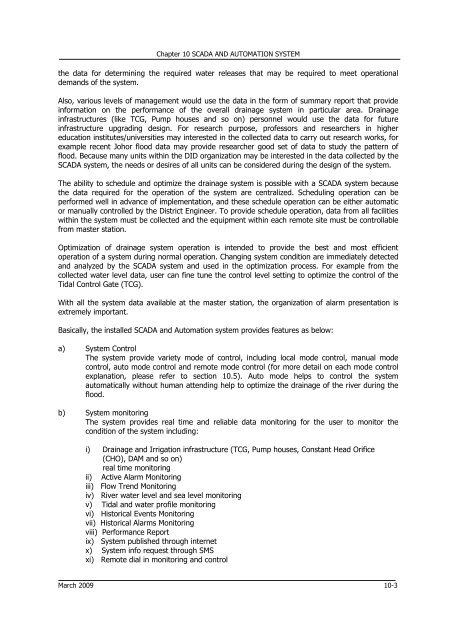Volume 8 – Mechanical and Electrical Services - Malaysia Geoportal
Volume 8 – Mechanical and Electrical Services - Malaysia Geoportal
Volume 8 – Mechanical and Electrical Services - Malaysia Geoportal
Create successful ePaper yourself
Turn your PDF publications into a flip-book with our unique Google optimized e-Paper software.
Chapter 10 SCADA AND AUTOMATION SYSTEM<br />
the data for determining the required water releases that may be required to meet operational<br />
dem<strong>and</strong>s of the system.<br />
Also, various levels of management would use the data in the form of summary report that provide<br />
information on the performance of the overall drainage system in particular area. Drainage<br />
infrastructures (like TCG, Pump houses <strong>and</strong> so on) personnel would use the data for future<br />
infrastructure upgrading design. For research purpose, professors <strong>and</strong> researchers in higher<br />
education institutes/universities may interested in the collected data to carry out research works, for<br />
example recent Johor flood data may provide researcher good set of data to study the pattern of<br />
flood. Because many units within the DID organization may be interested in the data collected by the<br />
SCADA system, the needs or desires of all units can be considered during the design of the system.<br />
The ability to schedule <strong>and</strong> optimize the drainage system is possible with a SCADA system because<br />
the data required for the operation of the system are centralized. Scheduling operation can be<br />
performed well in advance of implementation, <strong>and</strong> these schedule operation can be either automatic<br />
or manually controlled by the District Engineer. To provide schedule operation, data from all facilities<br />
within the system must be collected <strong>and</strong> the equipment within each remote site must be controllable<br />
from master station.<br />
Optimization of drainage system operation is intended to provide the best <strong>and</strong> most efficient<br />
operation of a system during normal operation. Changing system condition are immediately detected<br />
<strong>and</strong> analyzed by the SCADA system <strong>and</strong> used in the optimization process. For example from the<br />
collected water level data, user can fine tune the control level setting to optimize the control of the<br />
Tidal Control Gate (TCG).<br />
With all the system data available at the master station, the organization of alarm presentation is<br />
extremely important.<br />
Basically, the installed SCADA <strong>and</strong> Automation system provides features as below:<br />
a) System Control<br />
The system provide variety mode of control, including local mode control, manual mode<br />
control, auto mode control <strong>and</strong> remote mode control (for more detail on each mode control<br />
explanation, please refer to section 10.5). Auto mode helps to control the system<br />
automatically without human attending help to optimize the drainage of the river during the<br />
flood.<br />
b) System monitoring<br />
The system provides real time <strong>and</strong> reliable data monitoring for the user to monitor the<br />
condition of the system including:<br />
i) Drainage <strong>and</strong> Irrigation infrastructure (TCG, Pump houses, Constant Head Orifice<br />
(CHO), DAM <strong>and</strong> so on)<br />
real time monitoring<br />
ii) Active Alarm Monitoring<br />
iii) Flow Trend Monitoring<br />
iv) River water level <strong>and</strong> sea level monitoring<br />
v) Tidal <strong>and</strong> water profile monitoring<br />
vi) Historical Events Monitoring<br />
vii) Historical Alarms Monitoring<br />
viii) Performance Report<br />
ix) System published through internet<br />
x) System info request through SMS<br />
xi) Remote dial in monitoring <strong>and</strong> control<br />
March 2009 10-3

















